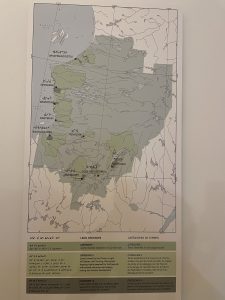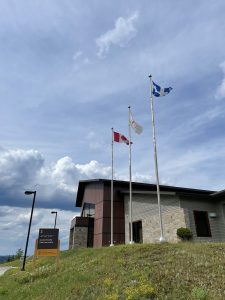By Hannah Reardon
The views expressed in this post are the author’s alone.
*This post contains some descriptions of colonial violence, including mentions of residential schools and displacement.
In my work for the Cree Nation Department of Justice and Correctional Services I have been providing support to the team of Gladue[1] writers by researching the history of each of the nine Cree communities that make up the Cree Nation in Eeyou Istchee, the traditional territory of the Eeyou Enouch, which stretches from Lake Mistissini to the northern limits of James Bay. While Gladue reports focus primarily on the individual’s life story, they should also include reference to the individual’s community history. The community history provides context in order to elucidate the inter-generational impacts of colonialism, such as displacement and residential schools, and their effects in generating conditions which can lead to a higher incidence of criminality, including poverty, unemployment, substance abuse, and lower educational attainment.[2]

One of the things that has struck me the most in my research has been the observation that many of the most severe instances of colonial violence in Eeyou Istchee have occurred within the past century and are the direct result of malicious policy initiatives spearheaded by the federal and provincial governments. This has been particularly striking to me because it flies directly in the face of the false, but commonly-held, belief of many Canadians that the colonial oppression of Indigenous peoples occurred in a distant past and under a different political regime. Although for many people reading this post this is surely not a revelation, there is something about reading of specific instances of recent and devastating colonial violence and reflecting on their ongoing impacts in the lives of people you interact with in an intimate professional setting that makes something you “know” in the abstract really sink into your bones.
Let me provide a couple of examples of what anthropologist Tony Morantz has called “bureaucratic colonialism”[3] in order to illustrate my point. Comprehensive Western health services did not arrive in Eeyou Istchee until after WWII. Early government planning documents demonstrate a desire by federal officials within the department of Indian Affairs to impress “civilization” upon the Cree by demonstrating “white man’s skill in healing”.[4] Ironically, this “skill in healing” was catastrophically ineffective and it had the additional consequence of subverting many traditional forms of healing. Poorly-funded programs were unable to stop public health crises in the communities and many community-members were flown south to receive treatment for illnesses such as tuberculosis, measles, smallpox or influenza.[5] These displacements were undoubtedly traumatic, particularly for those who were sent to southern sanatoriums to heal from tuberculosis and were forced to remain there, dislocated from their communities and their loved ones for years at a time.[6]
Education policies also represent concerted efforts from the federal and provincial governments to assimilate the Cree into Western society. Anglican day schools were run in Waskaganish, Nemaska, Mistissini, and Waswanipi.[7] Residential schools – both Catholic and later public – ran in Chisasibi (formerly Fort George), Whapmagoostui, and Mistissini.[8] Other children were taken and sent further afield to residential schools in Amos, La Tuque, or in Ontario. The separation of children from their families created a great generational divide. The trauma resulting from these institutions is well-known, but it is not distant history. The last Catholic residential school in Eeyou Istchee closed in 1981.[9]

Today, health, education, policing, and justice services (among many others) are provided by the Cree for their own communities. The James Bay and Northern Quebec Agreement (JBNQA)[10] and numerous subsequent agreements have created a framework for the Cree Nation in Eeyou Istchee to exercise its administrative sovereignty over many aspects of community life. By way of example, the Cree Board of Health and Social Services offers services in all nine Cree communities, including a regional hospital in Chisasibi. It delivers services in accordance with Cree values, as per section 14 of the JBNQA. [11] Similarly, section 16 of the JBNQA allowed for the establishment of the Cree School Board, which now offers high quality education to students. Classes offered in Cree, English and French integrate Cree culture and values, thereby fostering a revitalization of Cree language and culture for the next generations.[12]
Of course, the Cree Nation Department of Justice and Correctional Services is also very much a part of the JBNQA’s renewal of Cree sovereignty over internal affairs. The DJCS offers support to victims and perpetrators of criminal acts in their interactions with the provincial and federal justice systems. It can even divert some cases out of the provincial and federal criminal justice systems by working with local Community Justice Committees.[13]

I am proud and humbled to be working for this incredible organization this summer, and to be working with all the amazing people who provide the department’s innovative and meaningful services. The JBNQA was transformative for the Eeyou Enouch, and the power of Cree governance demonstrates that returning land and sovereignty to Indigenous peoples is the key to healing from the violence of colonialism. Just as misguided centralized governance created institutionalized violence in the recent past, we might ask which current policies contribute to the ongoing institutional violence that many Indigenous people still face in the criminal justice system, the child welfare system, and the health system (to name just a few). As law students, we have a role to play in addressing these failures of the current system. For those of us who are settlers on this land, we also have a crucial role to play. As we rise to the challenge, we must remember to tread with humility, and to remain critical of the status quo.
[1] For those unfamiliar with Gladue reports, see Tim Parr, “Some Thoughts On Gladue” (28 July 2021), online (blog): McGill Human Rights Interns <blogs.mcgill.ca/humanrightsinters/tag/timparr>.
[2] See R v Gladue, [1999] 1 SCR 688 at paras 67-69. See also R v Ipeelee, 2012 SCC 13 at para 60.
[3] Tony Morantz, The Man’s Gonna Getcha (Montreal & Kingston: McGill-Queen’s University Press, 2002) at 134.
[4] See Ronald Niezen, Defending the Land: Sovereignty and Forest Life in James Bay Cree Society, 2nd ed (Upper Saddle River, New Jersey: Pearson Prentice Hall, 2009) at 40.
[5] Morantz, supra note 3, at 189.
[6] Ibid.
[7] Gowling WLG, “Schedule K” (last visited 26 July 2022), online (pdf): Federal Indian Day School Class Action < https://indiandayschools.com/en/wp-content/uploads/schedule-k.pdf>.
[8] National Centre for Truth and Reconciliation, “Quebec Residential Schools” (last visited 26 July 2022) online: University of Manitoba < https://nctr.ca/residential-schools/quebec/>.
[9] Indian residential School History & Dialogue Centre, “Fort George Roman Catholic (QC)”, (last visited 26 July 2022), online: University of British Columbia < https://collections.irshdc.ubc.ca/index.php/Detail/entities/1160>.
[10] James Bay and Northern Quebec Agreement, 11 November 1975, online (pdf): Grand Council of the Crees (Eeyou Istchee) Cree Nation Government < https://www.cngov.ca/resource/james-bay-and-northern-quebec-agreement-1975/01-_james_bay_and_northern_quebec_agreement__consolidated_to_september_13__2013_-1/>.
[11] Cree Board of Health and Social Services of James, “Our Mission” (last visited 26 July 2022), online: Cree Health, <https://www.creehealth.org/about-us/our-mission>.
[12] Cree School Board, “Our Organization: Teaching & Learning” (last visited 26 July 2022), online: Eeyou Education, <https://eeyoueducation.ca/org/teaching>.
[13] Cree Nation Government, Department of Justice and Correctional Services, “Community Justice Committee”, online: Cree Justice <https://www.creejustice.ca/index.php/ca/community-justice/community-justice-committee>.
